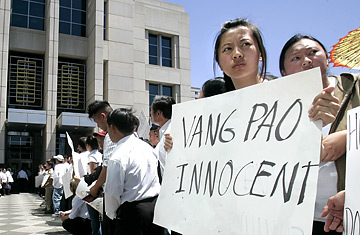
A protester holds a sign in support of Gen. Vang Pao during a demonstration calling for his release on charges of trying to overthrow the government of Laos, in Sacramento, Calif., Monday, June 11, 2007.
If the people strolling the streets of Laos' sleepy capital, Vientiane, were worried about a violent overthrow of their government, they weren't showing their alarm. Earlier this summer, U.S. authorities arrested 11 people in California for allegedly plotting to topple one of the world's last Marxist regimes.
Among those charged with conspiracy to kill, kidnap and maim, among other accusations, was General Vang Pao, a member of the Hmong minority whose guerrilla forces had been funded by the CIA during the Vietnam War to fight the Viet Cong-aligned communists of the Pathet Lao. Along with an estimated 200,000 Laotian Hmong, Vang Pao fled to the U.S. after America withdrew from Indochina in 1975 and communist forces took over Laos and Vietnam. Now, the 77-year-old ex-CIA operative, along with nine other Laotian-born Americans and a former U.S. Army ranger who served in Vietnam, is facing potential life imprisonment for purportedly trying to send Stinger missiles and other high-grade weapons to a handful of Hmong guerrillas back home who are fighting to overthrow the government.
As dramatic as the California indictment may sound, no one I met in Vientiane had ever heard of this surreal plot. Of course, it may simply not be the sort of news the nation's secretive leaders are keen to disseminate. The first morning I was in Vientiane, the front page of the Times, the local English-language daily, heralded booming comradely relations with Vietnam, and the donation of some computers by a Scandinavian NGO. Not a single negative news story marred the sunny propaganda spirit of the paper.
Among the sensitive topics studiously avoided by the local media is the plight of the roughly 300,000 Hmong that remain in Laos. Persecuted because of their pro-American, anti-communist stance during the war, many Hmong retreated to remote mountain jungles to avoid further government reprisals. Clashes between government troops and ragtag Hmong forces continue to this day, and refugees have poured into neighboring Thailand. This month, U.S. lawmakers petitioned the Thai King to halt the deportations of 8,000 Hmong living in makeshift settlements along the Thai-Laos border. Many of the refugees claim they are descendants of soldiers who fought for Vang Pao's CIA-funded army, and say they will be forced into labor camps or imprisoned if sent back home.
Meanwhile, Vang Pao and several co-defendants claim, through their lawyers, that the CIA knew all about their recent attempt to send American weapons to Hmong guerrillas in Laos. They allege they had no idea their plot contravened the U.S. Neutrality Act, which criminalizes any action taken on domestic soil against a foreign government with which Washington is at peace.
When Vang Pao was released on bail last month, he was greeted by hundreds of Hmong supporters who continue to revere him as a leader who helped thousands of Hmong-Americans adjust to life in a strange new land. (Many Hmong living in the U.S. are believed to suffer from post-traumatic stress syndrome because of their wartime experiences.) To the prosecution team in his case, however, Vang Pao is a terrorist who is intent on arming rebels against a friendly government. And to the people of Laos? The day I left Vientiane, the Times finally did run an item on the Hmong. It was a small ad announcing a sale of Hmong handicrafts at a government-run tourist shop.
"Don't bother," advised a local acquaintance. "Those handicrafts aren't really made by them." That, it appeared, was the only local information I would glean about the Hmong of Laos.
